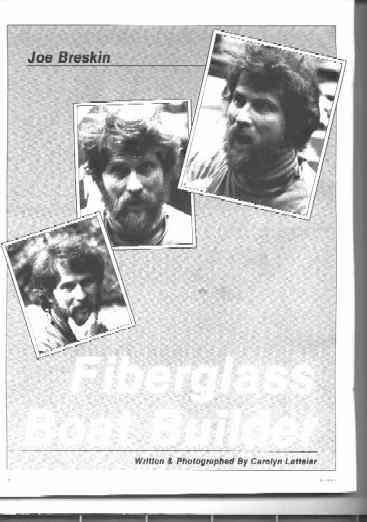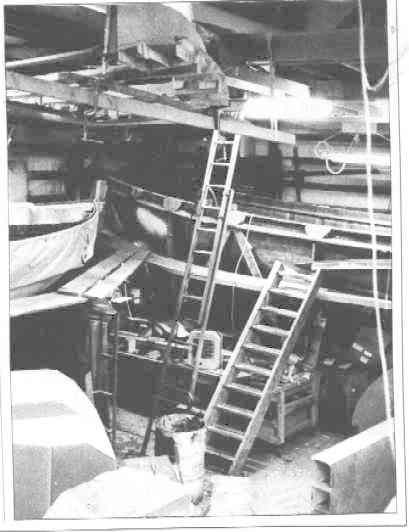
"When people come to me to build them a boat," said Breskin, "they believe it will be a tool that enables them to do something they couldn't do without it. You could spend three months out of every year for the rest of your life cruising anywhere in the world for less than it would cost to buy one of these (38 foot) boats. Most boats stay moored except for two or three weeks out of the year. They are fulfilling a mythological rather than a real need in a person's life. "
This is all part of the screening process Breskin puts his clients through as a matter of conscience. But in spite of this prickly approach to marketing and the fact that he hasn't advertised for years, Breskin has more projeas than he can handle: boats of all sizes as well as the musical instruments and audio equipment that has been his sideline for the last 20 years.
Breskin is a man whose mind operates at warp speed, often hovering close to circuit overload. His shop reflects that richness. "I generate this kind of environment everywhere 1 go, " Breskin confesses as he stands happily in the chaos of a million curiosities: half finished projects, tools, casks and barrels of chemicals. The shop is convertible to a number of different uses; the two thirty-eight foot boats presently in progress are both in metal cradles on wheels. Jury-rigged ladders lead to small specialized workshops suspended from the rafters and growing from the catwalks overhead.
Among the clutter is a mold for a fiberglass baby grand piano, several guitar necks and parts of an auditorium sized sound system. What he call his "industrial strength youth deafening devices " are selling well. He makes the horn throats from fiberglass and the cabinets from multiple layers of oriented-strand board, an acoustically "dead" material.
Breskin wasn't supposed to be a boat builder. "I thought I was going to be a car designer, " he said, "but at 13 I discovered radio and went off the deep end into music. " Beginning in the seventh grade until he was almost 30 he played lead guitar in a variety of rock and roll bands. But the further up he climbed in the music business, the more precipitous seemed the height. "It started to look like there were few honest livings to be made in popular music. It got to the point where my friends either got famous or died in the attempt. "
The choice was too scarey. Breskin dropped out and returned to the University of Washington to hide out for a while. Eventually he and his wife started an auto repair school in Seattle which they ran for several years.
"About that time my father's mythological boat lust tempted him to invest in a fledgling sailboat manufacturing operation in Port Townsend. " The factor that Breskin senior sent to investigate the company's books reported that it was a hollow company that had been milked of its assets and was about to collapse. When the company fell on its face it left a number of would-be boat owners holding worthless contracts on unfinished boats. Breskin senior bought the molds at auction and started a new business which Joe soon took over.
He had learned the basics of fiberglass while making airplane interiors for Boeing. "I paid the salesman from King Fiberglass to be a consultant and yell at me on my first big gelcoat job. I hired people to do things, atched them and paid them to explain what they were doing... some people in town thought I was a vampire." Breskin doesn't see it that way. He has his own code of ethics which includes helping out the cheated customers of his original parent company. He still feels bad about their losses and has made it a policy to give them free shop space, advice and discounted materials.

Seven Seas began with an Ingrid hull mold and matching deck mold which make up into a 38 foot double ended boat. The original design come from the 1930s depression days when folk needed fodder for dreams. Designer Bill Atkin was paid $25.00 for a set of drawings to be published in Motor Boating. The design incorporated the romance of the Northsea lifeboat.
"After the depression ended in war and the war ended in prosperity, " said Breskin, "the fiberglass technology that had been developed for the war started to trickle down to the making of boats." A Seattle cooperative built the first plug for an Ingrid mold out of sheetrock.
Later a boat from that mold made its way to Port Townsend and served illegally as a plug for a new mold. The plastic stuck to the boat which was eventually destroyed to free up the mold. This lead to the the creation of yet anopther mold - the one that Breskin began with. At that time it still needed a lot of work. Whether because the original sheetrock plug had buckled badly or because the plastic mold had flowed the wrong way (plastic flows and molds are constantly changing shape), the Ingrid was not capable of producing a fair hull. "A deviation in the curve of a boat is an out of fairness, " said Breskin. "Somebody with a trained eye can spot an out of fairness of 1/16 of an inch on an 80 foot boat across the bay. It becomes something of a curse." Breskin fixed the fairness in the mold and 14 motorsailers have been pulled from it in the last nine years. He describes them as the "Packards " of sailboats: strong, sturdy, dependable. "For the first five years I wanted to be the best fiberglass boat builder in the world. Eventually I realized nobody else was playing the same game; they were all trying to be the richest. Occasionally I would see moments of brilliance in their work, but there were no signs of sustained quality. " In the end Breskin awarded himself the title by default.

Breskin also layers his hulls differently than most fiberglass builders. The usual method is to lay a layer of mat with a layer of fiberglass and then the resin, which is worked down through the cloth. Breskin applies a good part of the resin first. It's harder to work it through from behind, but this method floats the tiny, hidden air bubbles out of the hull instead of pressing them deeper in where they may eventually erupt in the pox. Breskin is able to absorb some of this extra expense because of a special process that enables him to make complex molds very cheaply, and because he has developed production techniques which make the operation more efficient. The financial side of boat building has been a preoccupation for Breskin since he rescued Seven Seas from the wreckage of the company he calls "a mini-WPPSS. " He looked around and saw that every boat builder in Port Townsend was operating on a time and materials or cost-plus basis. The same principle is used for defense contracts, which sometimes come out costing many times the original estimate. Breskin saw that happening with boats and he thought it was unfair. "With a cost-plus system," he said. "the more mistakes you make, the more money you make."
Today, Breskin too is operating on a time and materials basis. He gives his customers a detailed computer print~ut of what the last guy paid for a similar job, hoping thus to keep delusion to a minimum. During the project they get a complete audit trail of expenses. But 1 don't want to go on sharing stress someone who is writing me the biggest check he will ever write in his life," said Breskin who is now moving in a new direction. he conceived a series of designs for smaller, simpler boats that would be more manageable both physically and financially. The boat he would choose to build for himself had to have a functional galley, bathroom, sleeping quarters and place to keep things dry. But it also had to be able to plane under sail. The resultant 17 foot boat weighs 600 pounds, and because of the way the shrouds are attached, can be off the boat trailer and under sail in half an hour. With sails and trailer it can be built for less than $10,000.
Breskin made plans and a model and sold one boat from the drawings and starred building the new mold, but the urge for simplicity carried him farther. That summer he and his wife began taking weekends off and spending them backpacking in the high country of the Olympic Mountains. Now he is ready to move entirely from the Winnebago to the mountain-tent of boats. Currently Breskin is working on a project to build cost effective Sea kayaks. He has set up a production line that could turn them out at a good price. Breskin is feeling good about moving from long term, expensive projects which weigh him down with moral considerations and psychic shadows to small, intimate, affordable boats. "I've started thinking closer to the water is more interesting. Smaller and cheaper seem more attractive. " He looks forward to paddling his own Light weight kayak on the waters of Discovery Bay. Like the rest of us, Breskin has his own mythological lust to satisfy.
Written and Photographed by Carolyn Latteier - February 1986